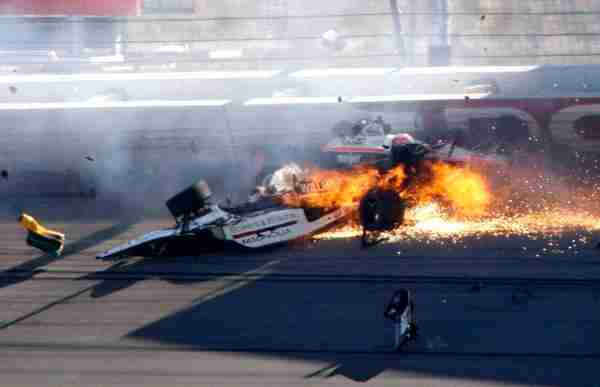CHARLOTTE, N.C. — The death of Indianapolis 500 winner Dan Wheldon has sparked discussions about safety in motorsports as NASCAR heads to one of the fastest tracks on its circuit.
The death of Wheldon, killed Sunday in a spectacular 15-car crash at Las Vegas Motor Speedway, has drawn particular attention from a curious public often amused by crashes and pileups. Last weekend, the crowd at Charlotte Motor Speedway roared with approval when five-time NASCAR champion Jimmie Johnson crashed hard into the wall.
NASCAR, which has made significant safety improvements in the decade since its last fatal crash, now heads to Talladega Superspeedway. The 2.65-mile track is four lanes wide, has 33-degree bank in the corners and, like its sister track, Daytona International Speedway, has long been known as a place where “the biggest crash” can happen in the blink of an eye.
“Talladega is fast, it’s got a lot of corners and we all know what to expect when we go there,” Robin Pemberton, NASCAR’s vice president of competition, said earlier this week.
NASCAR mandates the use of horsepower-reducing restrictor plates at Daytona and Talladega to limit speeds of up to 200 mph. Bill Elliott holds the all-time NASCAR qualifying record with a lap of 212 mph in 1987, the same race in which Bobby Allison nearly died when his car crashed into the fence.
Restrictor plates were imposed at Daytona and Talladega that season.
The track was also the scene of a scary crash in 2009 involving current Sprint Cup Series points leader Carl Edwards.
Edwards’ car went airborne and hit the guardrail, which bent but held and sent his car back onto the track. He then got out of his car and ran on foot to the finish line.
This race was one of the first indications of how two cars could work together in the draft, as Brad Keselowski and Edwards had been slamming into each other for the lead. Edwards’ crash happened as Keselowski was passing him for the lead, and the two cars touched as Edwards tried to block the pass.
Since then, the two-car tandem has become the primary mode of racing for drivers at Daytona and Talladega. In an attempt to limit two-car tandems, NASCAR increased the size of the restrictor plate and ordered a valve adjustment on the cooling system.
The changes are expected to allow cars to go up to 5 mph faster, but the cooling system change means engines could overheat more quickly and force cars to not stay locked together for too long. NASCAR has indicated it doesn’t want cars to maintain 200 mph for too long, and Johnson said it’s up to the sanctioning body to keep an eye on the numbers and make sure speeds don’t get too high.
The faster the car, the easier it is to take off.
“There’s a threshold for all cars where they’re in the air, and as we go to Talladega with a bigger restrictor plate, we’re getting closer to that threshold,” Johnson said.
The danger and excitement it brings are what draws many fans to Talladega and Daytona, which is why many fans unhappy with the two-car racing style have howled after each of the first three races of the season.
Never mind that the races produced record lead changes and fabulous finishes: there seemed to be genuine anger at the lack of drama created by 43 cars racing door-to-door for 500 miles.
In an effort to maintain its reputation as NASCAR’s “most competitive track,” Talladega is offering a $100,000 bonus this weekend to the driver who makes the most passes for the lead. The April race at Talladega saw a NASCAR record 88 lead changes, and the track believes it could see as many as 100 on Sunday.
“Our fans are looking forward to seeing a lot of passing and lead changes,” Talladega president Grant Lynch said. “It makes sense to put in an extra incentive to give our fans what they want. The new rules, which include a wider restrictor plate opening, should give drivers the ability to really mix it up and pass even more in traffic.” Wheldon was racing for a $5 million bonus offered by IndyCar on Sunday if he could win the race from the back of the field. While that didn’t play a role in his death, critics have pointed out that the incentive could motivate him to drive aggressively through the field.
The Talladega offer is unlikely to prompt drivers to race differently, although four-time Talladega runner-up Kurt Busch has said he would try to win it.
“I told Grant we would definitely look to get his bonus money back,” Busch said.
“I’m sure the TV guys will know. We’ll do whatever we can to make that extra $100,000.” Yet there’s a sense of immortality in auto racing right now. Drivers know the risks, accept the danger and forget about it every time they get in the car. For all the safety improvements in the 10 years since Dale Earnhardt’s fatal crash on the final lap of the 2001 Daytona 500, the job is never done, and Wheldon’s death made that clear to everyone.
“You’re never going to get to safety,” said driver Jeff Burton, one of NASCAR’s most vocal safety advocates. “It’s not a goal, it’s an effort, and there’s no way you’re ever going to get to the level you want to get to.”

